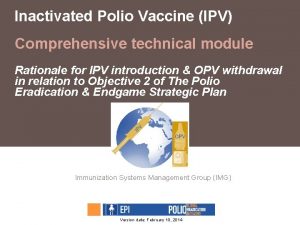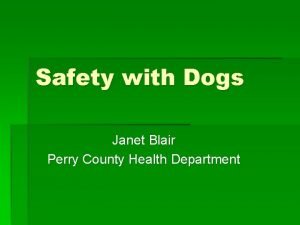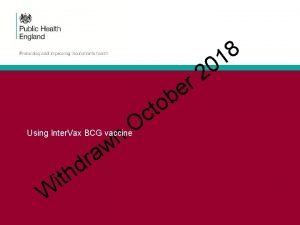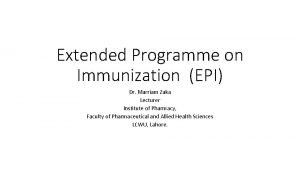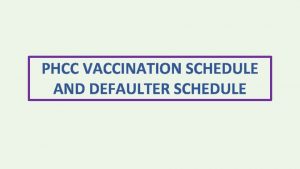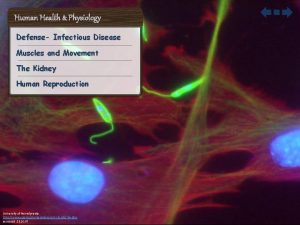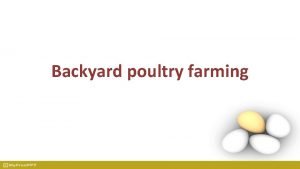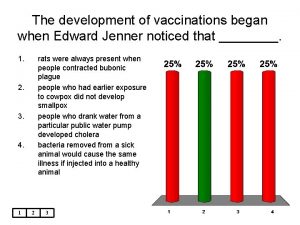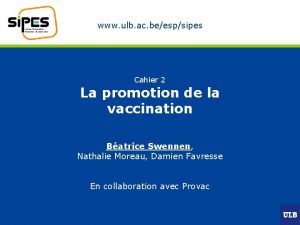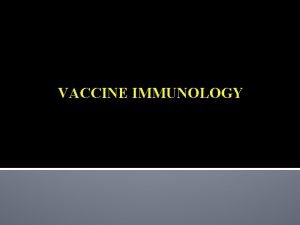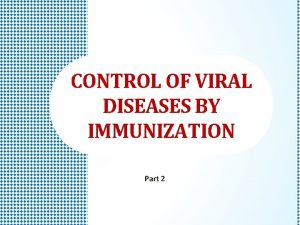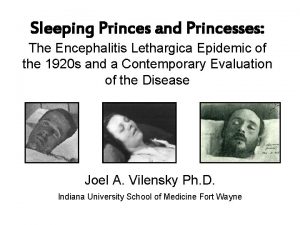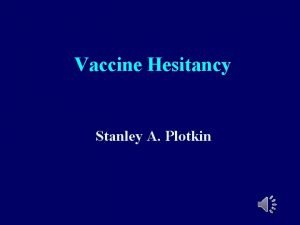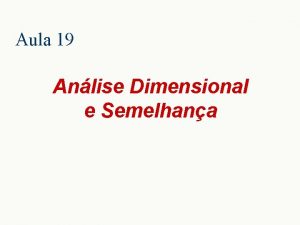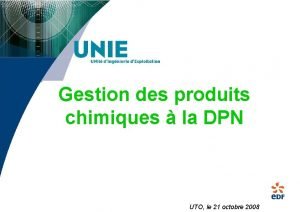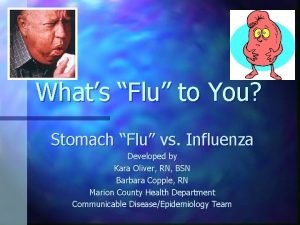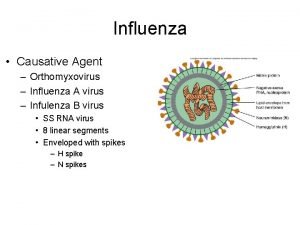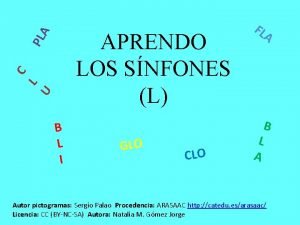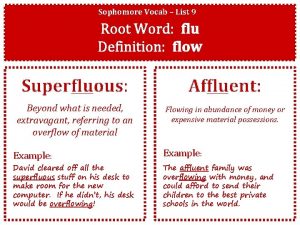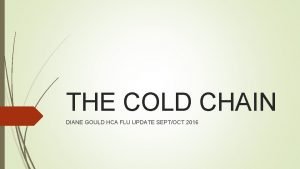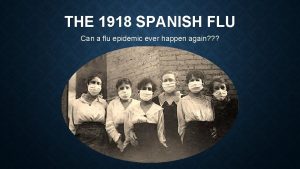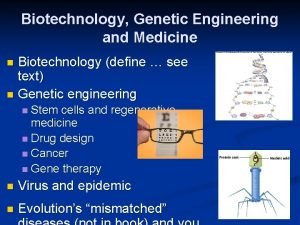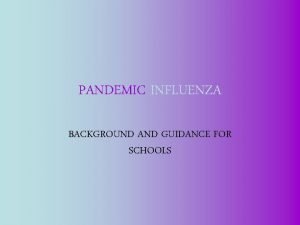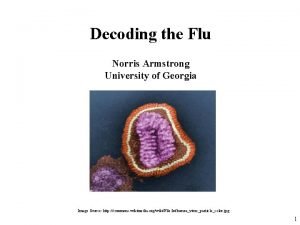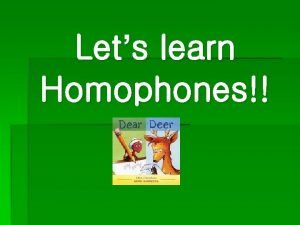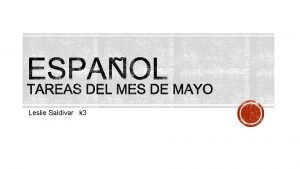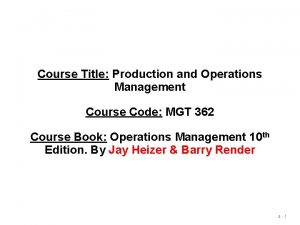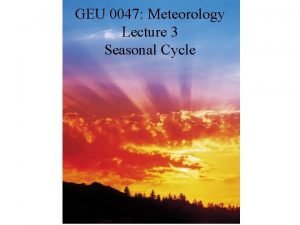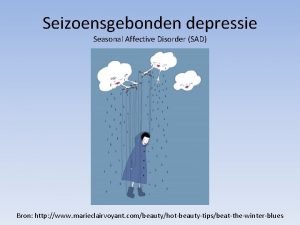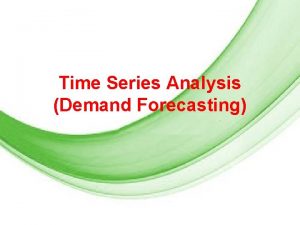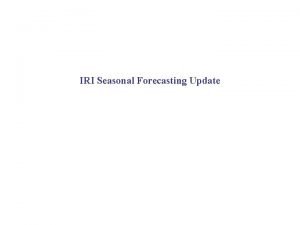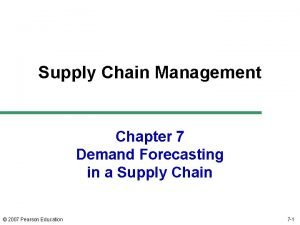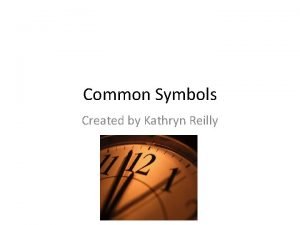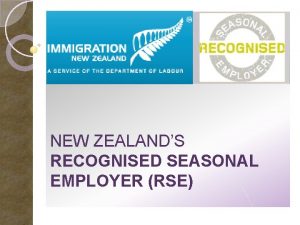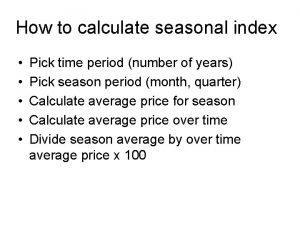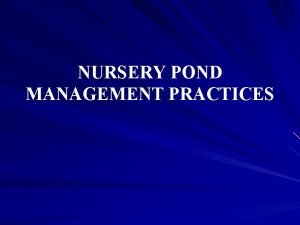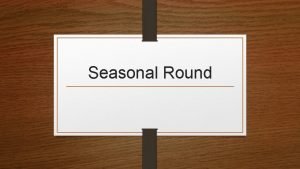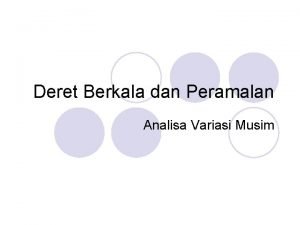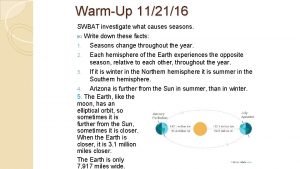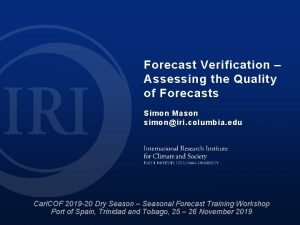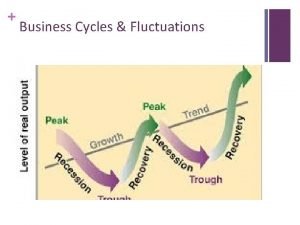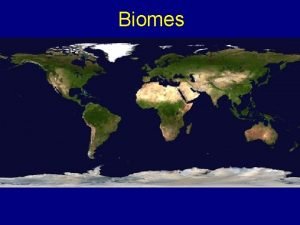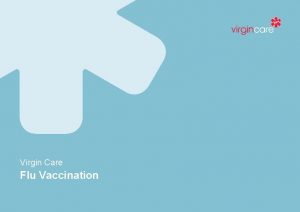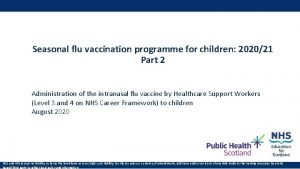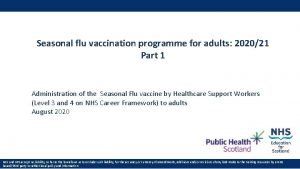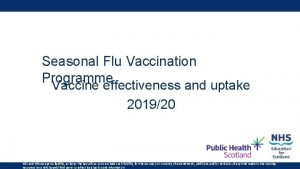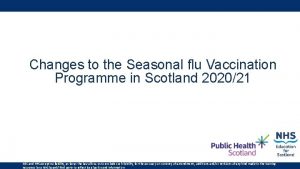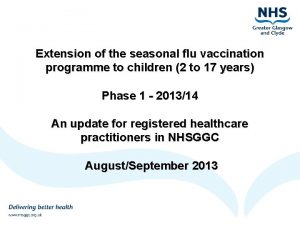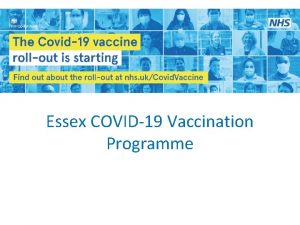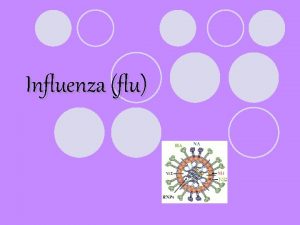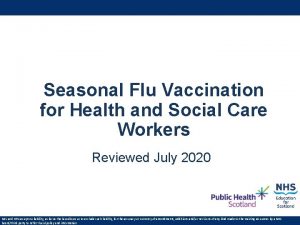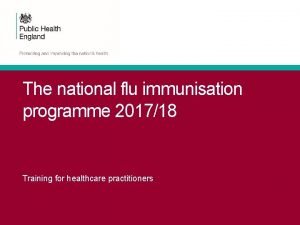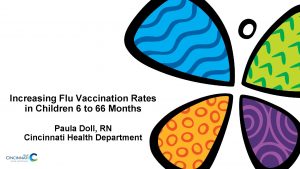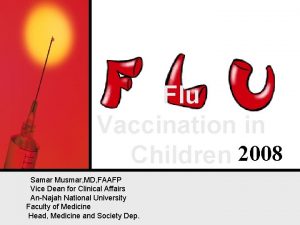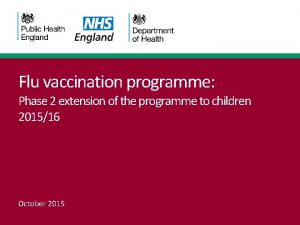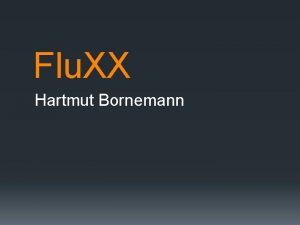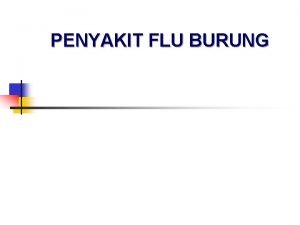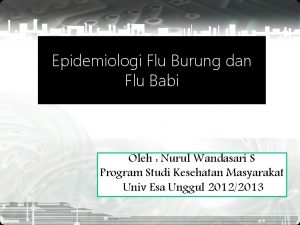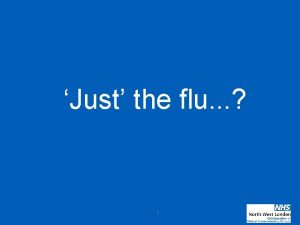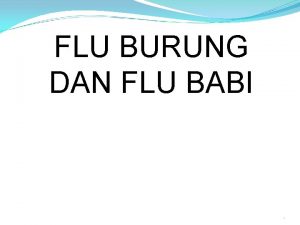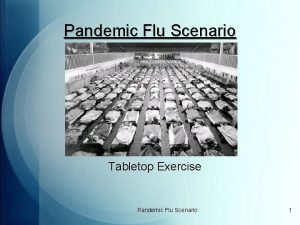Seasonal flu vaccination programme for children 201718 An






























































- Slides: 62

Seasonal flu vaccination programme for children: 2017/18 An update for registered healthcare practitioners January 2018

Seasonal Flu vaccination programme for children 2017/18 Eligibility • In 2017/18, 2 -5 year olds* not yet in school and all primary school aged children will continue to be offered flu vaccination (children must be aged 2 or above on 1 September 2017 • All primary school aged children (primary 1 -primary 7) • With the exception of children in clinical risk groups at increased risk of complications, children in secondary school are not currently included in the programme NES and HPS accept no liability, as far as the law allows us to exclude such liability, for the accuracy or currency of amendments, additions and/or revisions of any kind made to the training resources by a NHS board/third party to reflect local policy and information Page 1

Seasonal flu vaccination programme to children 2017/18 Green Book Chapter • There are no changes to the Green Book Chapter*- this contains detailed advice on the vaccine and associated contraindications. • Practitioners should ensure they are familiar with and refer to, the advice in the Green Book Chapter including contraindications and precautions before vaccinating patients (*at the time this resource was updated September 2017) NES and HPS accept no liability, as far as the law allows us to exclude such liability, for the accuracy or currency of amendments, additions and/or revisions of any kind made to the training resources by a NHS board/third party to reflect local policy and information Page 2

Seasonal Flu vaccination programme for children 2017/18 Influenza vaccine effectiveness in children in Scotland age 4 -11 years measured by attendance at hospital: provisional end-of-season results for the 2015 -16 season • • Estimated VE in children age 4 -11 years reveals significant protection against both clinically diagnosed influenza (68%) and lab confirmed influenza (63%) These findings are consistent with recent estimates of flu VE in a general practice population in the UK* and in Finnish 2 year old children** Source Health Protection Scotland NES and HPS accept no liability, as far as the law allows us to exclude such liability, for the accuracy or currency of amendments, additions and/or revisions of any kind made to the training resources by a NHS board/third party to reflect local policy and information Page 3

Key message • In 2012 the Joint Committee on Vaccination and Immunisation (JCVI) recommended that the seasonal influenza (flu) programme should be extended to all children aged 2 to less than 17 years of age, the phased introduction began in October 2013 • It is hoped that this extension to the flu vaccination programme will reduce the impact of seasonal flu on children and reduce transmission of flu within the community • Registered healthcare practitioners have a key role in promoting increased uptake of flu vaccination in children through increasing awareness NES and HPS accept no liability, as far as the law allows us to exclude such liability, for the accuracy or currency of amendments, additions and/or revisions of any kind made to the training resources by a NHS board/third party to reflect local policy and information Page 4

Aims of resource This resource aims to: • Develop the knowledge base of registered healthcare practitioners regarding the extension of the flu vaccination programme to children • Support registered healthcare practitioners involved in discussing flu vaccination for children with parents and carers by providing evidence based information • Promote increased uptake of flu vaccination in children through increasing awareness of those involved in the vaccination programme • Provide information on the administration of Fluenz™ Tetra NES and HPS accept no liability, as far as the law allows us to exclude such liability, for the accuracy or currency of amendments, additions and/or revisions of any kind made to the training resources by a NHS board/third party to reflect local policy and information Page 5

Learning outcomes On completion of this resource registered healthcare practitioners will be able to: • Understand the evidence base for the administration of the vaccination against flu to children • Describe the aetiology of flu • Have an understanding of how flu is transmitted and the possible effects of flu on children • Explain what vaccines will be used, the precautions and contraindications to the administration of flu vaccines • Explain the possible side effects of administration of flu vaccines • Explain the sequence of steps in Fluenz™ Tetra administration • Identify sources of additional information • Understand the importance of their role in raising the issue of vaccination with parents and carers of children and providing evidence based information about flu vaccination NES and HPS accept no liability, as far as the law allows us to exclude such liability, for the accuracy or currency of amendments, additions and/or revisions of any kind made to the training resources by a NHS board/third party to reflect local policy and information Page 6

Seasonal flu vaccination programme for children 2017/18 Contents • Overview of phasing of extension to flu immunisation programme • What is flu? • Why extend the seasonal flu immunisation programme to all children? • Vaccination of children against flu • Resources • References NES and HPS accept no liability, as far as the law allows us to exclude such liability, for the accuracy or currency of amendments, additions and/or revisions of any kind made to the training resources by a NHS board/third party to reflect local policy and information Page 7

Current flu vaccination programme in Scotland • In Scotland, there is an annual vaccination programme which aims to reduce the impact (morbidity and mortality) of flu particularly in high risk groups e. g. those aged 65 years or greater and those from age 6 months of age in clinical risk groups NES and HPS accept no liability, as far as the law allows us to exclude such liability, for the accuracy or currency of amendments, additions and/or revisions of any kind made to the training resources by a NHS board/third party to reflect local policy and information Page 8

What is flu? NES and HPS accept no liability, as far as the law allows us to exclude such liability, for the accuracy or currency of amendments, additions and/or revisions of any kind made to the training resources by a NHS board/third party to reflect local policy and information Page 9

What is Flu? • Flu is a highly infectious viral illness? NES and HPS accept no liability, as far as the law allows us to exclude such liability, for the accuracy or currency of amendments, additions and/or revisions of any kind made to the training resources by a NHS board/third party to reflect local policy and information Page 10

Influenza viruses • There are 3 types of influenza viruses: A B Causes epidemics and pandemics May cause epidemics Animal reservoir – wildfowl and pigs, also carried by other mammals Predominantly found in humans C Minor respiratory illness only NES and HPS accept no liability, as far as the law allows us to exclude such liability, for the accuracy or currency of amendments, additions and/or revisions of any kind made to the training resources by a NHS board/third party to reflect local policy and information Page 11

Influenza A virus • Genetic material (RNA) in the centre • Two surface antigens: – Haemagglutinin (H) – Neuraminidase (N) • Different types of each: – The blue protuberances represent haemagglutinin and the red spikes neuraminidase NES and HPS accept no liability, as far as the law allows us to exclude such liability, for the accuracy or currency of amendments, additions and/or revisions of any kind made to the training resources by a NHS board/third party to reflect local policy and information Page 12

Influenza virus Genetic change – what this means Antigenic drift: • Small constant mutations of H and N • Most current flu vaccines protect against the circulating strains of A (H 3 N 2) and A (HINI) along with one B virus. However, two brands including Fluenz™ Tetra provide protection against two strains of flu B. NES and HPS accept no liability, as far as the law allows us to exclude such liability, for the accuracy or currency of amendments, additions and/or revisions of any kind made to the training resources by a NHS board/third party to reflect local policy and information Page 13

Genetic change – what this means (cont. ) Antigenic shift: • Only occurs in Influenza A strains • A major change in one or both surface antigens, characteristic of Influenza type A viruses • It is due to genetic recombination when virus particles of more than one strain infect a cell simultaneously • It can result in a worldwide pandemic NES and HPS accept no liability, as far as the law allows us to exclude such liability, for the accuracy or currency of amendments, additions and/or revisions of any kind made to the training resources by a NHS board/third party to reflect local policy and information Page 14

Features of flu • • • Transmitted by large droplets, small-particle aerosols and by hand to mouth/eye contamination from an infected surface Incubation period 1 -5 days (average 2 -3 days) though may be longer especially in children and immunocompromised people Acute viral infection of respiratory tract Common symptoms include: • • • Sudden onset of fever, chills, headache, myalgia and severe fatigue Dry cough, sore throat and stuffy nose In young children gastrointestinal symptoms such as vomiting and diarrhoea may be frequently seen NES and HPS accept no liability, as far as the law allows us to exclude such liability, for the accuracy or currency of amendments, additions and/or revisions of any kind made to the training resources by a NHS board/third party to reflect local policy and information Page 15

Possible complications of flu Common: • Bronchitis • Otitis media (children), sinusitis Less common: • Secondary bacterial pneumonia • Meningitis, encephalitis • Primary influenza pneumonia • Most serious illness in neonates, pregnant women, older people and those with underlying disease NES and HPS accept no liability, as far as the law allows us to exclude such liability, for the accuracy or currency of amendments, additions and/or revisions of any kind made to the training resources by a NHS board/third party to reflect local policy and information Page 16

Why extend the seasonal flu vaccination programme to children? NES and HPS accept no liability, as far as the law allows us to exclude such liability, for the accuracy or currency of amendments, additions and/or revisions of any kind made to the training resources by a NHS board/third party to reflect local policy and information Page 17

Why vaccinate children? Extension of the seasonal flu vaccination programme to all children aims to appreciably lower the public health impact of flu by: • Providing direct protection to children thus averting a large number of cases of influenza disease in this group • Lowering influenza transmission from: – Child to child – Child to adult – Child to those in the clinical risk groups of any age The expected effect of the vaccination of children will then be a reduction in both the morbidity and mortality associated with flu (direct and indirect effect). NES and HPS accept no liability, as far as the law allows us to exclude such liability, for the accuracy or currency of amendments, additions and/or revisions of any kind made to the training resources by a NHS board/third party to reflect local policy and information Page 18

Cost effectiveness Studies commissioned by the JCVI 3 suggest that despite the high cost, extending the flu vaccination programme to low risk children is: • Highly likely to be cost-effective • Is well below the established cost-effectiveness threshold when indirect protection to the whole population is taken into account, particularly over the longer-term • Remains cost effective in circumstances where vaccine uptake by clinical risk groups was substantially increased NES and HPS accept no liability, as far as the law allows us to exclude such liability, for the accuracy or currency of amendments, additions and/or revisions of any kind made to the training resources by a NHS board/third party to reflect local policy and information Page 19

Recent observation/studies relating to flu and children Clinical trials on effectiveness of live attenuated influenza vaccine (LAIV): • Single dose of LAIV provides similar protection to children as two doses of inactivated influenza vaccine 4, 5 • Second dose of LAIV provides modest additional protection against flu infection (e. g. 60% v. 77% vaccine effectiveness for one and two doses, respectively)4 NES and HPS accept no liability, as far as the law allows us to exclude such liability, for the accuracy or currency of amendments, additions and/or revisions of any kind made to the training resources by a NHS board/third party to reflect local policy and information Page 20

Recent review of burden of flu in children • • • Average flu season: estimated 0. 3% to 9. 8% of 0 -14 year old children present to a GP with influenza 7 Incidence rates can be markedly higher in the younger age groups Flu associated hospitalisation rates: 8, 9, 10, 11, 12 – 83 -1038 / 100000 children 0 -59 months old (highest in <6 months) – 16 -210/100000 children 5 -17 years Children more vulnerable to infection than adults when exposed. 13, 14 Children with flu contribute to the burden of flu in all age groups because they are more likely to pass on the infection than adults 14, 15 NES and HPS accept no liability, as far as the law allows us to exclude such liability, for the accuracy or currency of amendments, additions and/or revisions of any kind made to the training resources by a NHS board/third party to reflect local policy and information Page 21

What is the additional evidence to support the offer of vaccination? • • • Trivalent inactivated vaccine (TIV) shown to be effective in eliciting a protective antibody response/averting flu like illness, when a two dose schedule is used for vaccine naïve children 16, 22, 24, 25 Live attenuated flu vaccine (LAIV) ~ 50% more effective than TIV in averting laboratory confirmed influenza 17, 18 Meta-analysis of six LAIV studies showed median VE of 78% (range: 57 -93) in children 6 months to 7 years 23 One dose of LAIV provides clinically significant protection against flu in young flu vaccine naïve children, with a second dose providing additional protection. Up to 90% of protection are conferred by the first dose 19, 20 LAIV is well tolerated in children and adolescents with asthma 21, 26 NES and HPS accept no liability, as far as the law allows us to exclude such liability, for the accuracy or currency of amendments, additions and/or revisions of any kind made to the training resources by a NHS board/third party to reflect local policy and information Page 22

Vaccination of children against flu NES and HPS accept no liability, as far as the law allows us to exclude such liability, for the accuracy or currency of amendments, additions and/or revisions of any kind made to the training resources by a NHS board/third party to reflect local policy and information Page 23

Types of vaccines Two main types of vaccine: • Inactivated - by intramuscular injection • Live - by nasal application Antibody levels may take 14 days to reach protective levels Protection lasts for at least one season. NES and HPS accept no liability, as far as the law allows us to exclude such liability, for the accuracy or currency of amendments, additions and/or revisions of any kind made to the training resources by a NHS board/third party to reflect local policy and information Page 24

Use of Fluenz™ Tetra NES and HPS accept no liability, as far as the law allows us to exclude such liability, for the accuracy or currency of amendments, additions and/or revisions of any kind made to the training resources by a NHS board/third party to reflect local policy and information Page 25

Use of Fluenz™ Tetra: • • Generic name: influenza vaccine (live attenuated, nasal) Brand name: Fluenz™ Tetra Marketed by Astra. Zeneca Licensed from 24 months to less than 18 years of age Nasal Spray (suspension) in a prefilled nasal applicator Supplied as pack containing 10 doses Container dimensions: 117. 5 x 115. 5 x 36 mm Provides greater protection for children than inactivated influenza vaccine NES and HPS accept no liability, as far as the law allows us to exclude such liability, for the accuracy or currency of amendments, additions and/or revisions of any kind made to the training resources by a NHS board/third party to reflect local policy and information Page 26

Use of Fluenz™ Tetra (cont. ) Fluenz™ Tetra composition Active ingredient Excipients Residues A/Michigan/45/2015(H 1 N 1)pd m 09 -like virus Sucrose Egg proteins (e. g. ovalbumin) A/Hong Kong/4801/2014(H 3 N 2) - like virus Dibasic potassium phosphate Gentamicin B/Brisbane/60/2008 -like virus Monobasic potassium phosphate B/Phuket/3073/2013 -like virus Gelatin (porcine type A) Arginine hydrochloride Monosodium glutamate monohydrate Water for injection NES and HPS accept no liability, as far as the law allows us to exclude such liability, for the accuracy or currency of amendments, additions and/or revisions of any kind made to the training resources by a NHS board/third party to reflect local policy and information Page 27

Use of Fluenz™ Tetra (cont. ) Fluenz™ Tetra presentation • Prefilled nasal applicator • Nasal spray (suspension) • Each applicator contains 0. 2 ml NES and HPS accept no liability, as far as the law allows us to exclude such liability, for the accuracy or currency of amendments, additions and/or revisions of any kind made to the training resources by a NHS board/third party to reflect local policy and information Page 28

Use of Fluenz™ Tetra (cont. ) Storage of Fluenz™ Tetra must be stored in accordance with manufacturer’s instructions: – Store between +2°C and +8°C – Store in original packaging – Protect from light • Before use, the vaccine may be taken out of the refrigerator, once for a maximum period of 12 hours at a temperature not above 25°C. If the vaccine has not been used after this 12 hour period, it should be disposed of in accordance with local procedures for disposal of clinical waste • Check expiry dates regularly: - Fluenz™ Tetra has an expiry date 18 weeks after manufacture – this is much shorter than inactivated flu vaccines • NES and HPS accept no liability, as far as the law allows us to exclude such liability, for the accuracy or currency of amendments, additions and/or revisions of any kind made to the training resources by a NHS board/third party to reflect local policy and information Page 29

Use of Fluenz™ Tetra (cont. ) Fluenz™ Tetra dosage and schedule • A single dose is 0. 2 ml (administered as 0. 1 ml per nostril) • A single dose for all children not in clinical at risk group • Children aged less than nine years who are in clinical at risk groups and who have not received flu vaccine before should receive two doses of Fluenz™ Tetra with the second dose at least four weeks after the first If the first dose is given in school the second dose will be given according to local NHS board arrangements. NES and HPS accept no liability, as far as the law allows us to exclude such liability, for the accuracy or currency of amendments, additions and/or revisions of any kind made to the training resources by a NHS board/third party to reflect local policy and information Page 30

Administration of Fluenz™ Tetra • Fluenz™ Tetra is different from other flu vaccines, it is a live intranasal vaccine • Fluenz™ Tetra must not be injected • Fluenz™ Tetra can be administered at the same time as other vaccines including live vaccines • Patient should breathe normally - no need to actively inhale or sniff • No need to repeat either half of dose if patient sneezes, blows their nose or their nose drips following administration NES and HPS accept no liability, as far as the law allows us to exclude such liability, for the accuracy or currency of amendments, additions and/or revisions of any kind made to the training resources by a NHS board/third party to reflect local policy and information Page 31

Administration of Fluenz™ Tetra (cont. ) The vaccine may only be administered: • Against a prescription written manually or electronically by a registered medical practitioner or other authorised prescriber: – Against a Patient Specific Direction – Against a Patient Group Direction NES and HPS accept no liability, as far as the law allows us to exclude such liability, for the accuracy or currency of amendments, additions and/or revisions of any kind made to the training resources by a NHS board/third party to reflect local policy and information Page 32

Administration of Fluenz™ Tetra Video clip showing administration Click on the following link to access the video clip showing how to administer Fluenz™ Tetra vaccine: http: //www. nes. scot. nhs. uk/education-and-training/ bytheme-initiative/public-health/health-protection/ seasonalflu. aspx NES and HPS accept no liability, as far as the law allows us to exclude such liability, for the accuracy or currency of amendments, additions and/or revisions of any kind made to the training resources by a NHS board/third party to reflect local policy and information Page 33

Fluenz™ Tetra Applicator Dose divider Barrel Rubber tip protector Plunger NES and HPS accept no liability, as far as the law allows us to exclude such liability, for the accuracy or currency of amendments, additions and/or revisions of any kind made to the training resources by a NHS board/third party to reflect local policy and information Page 34

Administration of Fluenz™ Tetra NES and HPS accept no liability, as far as the law allows us to exclude such liability, for the accuracy or currency of amendments, additions and/or revisions of any kind made to the training resources by a NHS board/third party to reflect local policy and information Page 35

Administration of Fluenz™ Tetra (cont. ) NES and HPS accept no liability, as far as the law allows us to exclude such liability, for the accuracy or currency of amendments, additions and/or revisions of any kind made to the training resources by a NHS board/third party to reflect local policy and information Page 36

Administration of Fluenz™ Tetra (cont. ) NES and HPS accept no liability, as far as the law allows us to exclude such liability, for the accuracy or currency of amendments, additions and/or revisions of any kind made to the training resources by a NHS board/third party to reflect local policy and information Page 37

Use of Fluenz™Tetra Infection control issues: There are no specific infection control precautions required when administering Fluenz™ Tetra • Routine hand hygiene procedures should be performed before and after each child contact • As a precaution, very severely immunosuppressed individuals should not administer live attenuated flu vaccine • Other healthcare workers who are immunosuppressed or pregnant, should follow normal clinical practice to avoid inhaling the vaccine and ensure that they are appropriately vaccinated Disposal of clinical waste: • Empty Fluenz™ Tetra vaccines should be disposed of in accordance with local procedures for disposal of clinical waste • NES and HPS accept no liability, as far as the law allows us to exclude such liability, for the accuracy or currency of amendments, additions and/or revisions of any kind made to the training resources by a NHS board/third party to reflect local policy and information Page 38

Use of Fluenz™ Tetra Contraindications • Age under 2 years • Age 18 years or above • Confirmed anaphylactic reaction to a previous dose of flu vaccine • Confirmed anaphylactic reaction to any component of the vaccine (except for ovalbumin [egg protein]) NES and HPS accept no liability, as far as the law allows us to exclude such liability, for the accuracy or currency of amendments, additions and/or revisions of any kind made to the training resources by a NHS board/third party to reflect local policy and information Page 39

Use of Fluenz™ Tetra Contraindications (contd. ) • Severe immunosuppression due to conditions or immunosuppressive therapy: – Acute and chronic leukaemias – Lymphoma – HIV positive patient not on highly active antiretroviral therapy – Cellular immune deficiencies – High dose steroids • Individuals receiving salicylate therapy (other than for topical treatment of localised conditions) • Known to be pregnant NES and HPS accept no liability, as far as the law allows us to exclude such liability, for the accuracy or currency of amendments, additions and/or revisions of any kind made to the training resources by a NHS board/third party to reflect local policy and information Page 40

Administration of Fluenz™ Tetra Precautions • Acute severe febrile illness – defer until recovered • Heavy nasal congestion – defer until resolved or consider inactivated influenza vaccine Please note: Minor illnesses without fever or systemic upset are not valid reasons to postpone vaccination NES and HPS accept no liability, as far as the law allows us to exclude such liability, for the accuracy or currency of amendments, additions and/or revisions of any kind made to the training resources by a NHS board/third party to reflect local policy and information Page 41

Administration of Fluenz™ Tetra Precautions (cont. ) • Fluenz™ Tetra should not be administered at the same time as use with antiviral agents against flu • Fluenz™ Tetra should not be administered within 48 hours of cessation of treatment with flu antiviral agents • Administration of flu antiviral agents within two weeks of administration of Fluenz™ Tetra may adversely affect the effectiveness of the vaccine NES and HPS accept no liability, as far as the law allows us to exclude such liability, for the accuracy or currency of amendments, additions and/or revisions of any kind made to the training resources by a NHS board/third party to reflect local policy and information Page 42

Fluenz™ Tetra - Egg Allergy • Except for these with severe anaphylaxis to egg which has previously required intensive care, children with an egg allergy can be safely vaccinated with Fluenz™ Tetra in any setting (including primary care and schools)* • Those with clinical risk factors that contraindicate Fluenz™ Tetra should be offered an inactivated influenza vaccine with a very low ovalbumin content (less than 0. 12 micrograms/ml) NES and HPS accept no liability, as far as the law allows us to exclude such liability, for the accuracy or currency of amendments, additions and/or revisions of any kind made to the training resources by a NHS board/third party to reflect local policy and information Page 43

Severe Asthma and active wheezing In cases of severe asthma or active wheezing: • Fluenz™ Tetra is not recommended: – for children currently taking oral steroids – prescribed oral steroid in the last 14 days • Fluenz™ Tetra should only be given on the advice of a specialist for children currently taking high dose of an inhaled steroid such as Budesonide greater than 800 micrograms/day or equivalent NES and HPS accept no liability, as far as the law allows us to exclude such liability, for the accuracy or currency of amendments, additions and/or revisions of any kind made to the training resources by a NHS board/third party to reflect local policy and information Page 44

Severe Asthma and active wheezing (Contd. ) • Fluenz™ Tetra should be deferred in: – children with a history of active wheezing in the past 72 hrs – children who have increased their use of bronchodilators in previous 72 hrs NES and HPS accept no liability, as far as the law allows us to exclude such liability, for the accuracy or currency of amendments, additions and/or revisions of any kind made to the training resources by a NHS board/third party to reflect local policy and information Page 45

Administration of Fluenz™ Tetra Risk of transmission: • There is a theoretical potential for transmission of live attenuated influenza virus in Fluenz ™ Tetra to immunocompromised contacts for one to two weeks following vaccination • However, where close contact with very severely immunocompromised patients (e. g. bone marrow transplant patients requiring isolation) is likely or unavoidable (e. g. household members) an appropriate alternative inactivated influenza vaccines should be considered NES and HPS accept no liability, as far as the law allows us to exclude such liability, for the accuracy or currency of amendments, additions and/or revisions of any kind made to the training resources by a NHS board/third party to reflect local policy and information Page 46

Fluenz™ Tetra -Suspected adverse reactions The most common adverse reactions following administration of Fluenz™ Tetra were: – nasal congestion/rhinorrhoea – reduced appetite – weakness – headache NES and HPS accept no liability, as far as the law allows us to exclude such liability, for the accuracy or currency of amendments, additions and/or revisions of any kind made to the training resources by a NHS board/third party to reflect local policy and information Page 47

Administration of Fluenz™ Tetra and pork gelatin • Fluenz™ Tetra contains pork (porcine) gelatin, an essential ingredient in many medicines, including some vaccines • Many faith groups have approved the use of gelatincontaining vaccines • It is, however, an individual choice whether or not to receive this vaccine and we recognise there will be diversity of thought within different communities NES and HPS accept no liability, as far as the law allows us to exclude such liability, for the accuracy or currency of amendments, additions and/or revisions of any kind made to the training resources by a NHS board/third party to reflect local policy and information Page 48

Reporting suspected adverse reactions Yellow card scheme • Voluntary reporting system for suspected adverse reaction to medicines/vaccines • Success depends on early, complete and accurate reporting • Report even if uncertain about whether vaccine caused condition • See: http: //mhra. gov. uk/yellowcard • See chapter 8 of Green Book for details NES and HPS accept no liability, as far as the law allows us to exclude such liability, for the accuracy or currency of amendments, additions and/or revisions of any kind made to the training resources by a NHS board/third party to reflect local policy and information Page 49

Use of Inactivated Flu Vaccine NES and HPS accept no liability, as far as the law allows us to exclude such liability, for the accuracy or currency of amendments, additions and/or revisions of any kind made to the training resources by a NHS board/third party to reflect local policy and information Page 50

Use of inactivated flu vaccine Presentation: • Supplied as pre-filled syringe • Must be shaken before they are administered Storage: • Store between +2°C and +8°C, in original packaging, protected from light Quadrivalent inactivated vaccine • Recommended for children from six months (Sanofi Pasteur) for whom Fluenz™ Tetra is not suitable Age restrictions: • Some flu vaccines are restricted to use in particular age groups. Practitioners must be familiar with and refer to the summary of product characteristics for the particular brand when administering vaccines NES and HPS accept no liability, as far as the law allows us to exclude such liability, for the accuracy or currency of amendments, additions and/or revisions of any kind made to the training resources by a NHS board/third party to reflect local policy and information Page 51

Use of inactivated flu vaccine (cont. ) Contraindications, precautions and adverse reactions Contraindications Precautions Adverse Reactions Confirmed anaphylactic reaction to flu vaccine Acute severe febrile illness defer until recovered Pain, swelling, redness at injection site Confirmed anaphylactic reaction to any component of the vaccine (other than ovalbumin [egg protein]) Low grade fever, malaise, shivering, fatigue, headache, muscle pain and joint pain NES and HPS accept no liability, as far as the law allows us to exclude such liability, for the accuracy or currency of amendments, additions and/or revisions of any kind made to the training resources by a NHS board/third party to reflect local policy and information Page 52

Reporting • Aggregate level data on vaccine uptake will be available on a 4 weekly basis. This will be provided on an all Scotland basis with additional information provided to each NHS board • End of season vaccination uptake data will be provided in a more detailed analysis NES and HPS accept no liability, as far as the law allows us to exclude such liability, for the accuracy or currency of amendments, additions and/or revisions of any kind made to the training resources by a NHS board/third party to reflect local policy and information Page 53

Key message • In 2012 the Joint Committee on Vaccination and Immunisation (JCVI) recommended that the seasonal flu programme should be extended to all children aged 2 to under 17 years of age, the phased introduction began in October 2013 • It is hoped that this extension to the flu vaccination programme will reduce the impact of seasonal flu on children and reduce transmission of flu within the community • Registered healthcare practitioners have a key role in promoting increased uptake of flu vaccination in children through increasing awareness NES and HPS accept no liability, as far as the law allows us to exclude such liability, for the accuracy or currency of amendments, additions and/or revisions of any kind made to the training resources by a NHS board/third party to reflect local policy and information Page 54

Resources Green Book http: //www. gov. uk/government/publications/influenza-the-green-bookchapter-19 CMO letter http: //www. sehd. scot. nhs. uk/cmo/CMO(2017)12. pdf Immunisation Scotland http: //www. immunisationscotland. org. uk/vaccines-anddiseases/seasonalflu/index. aspx Patient Group Directions http: //www. hps. scot. nhs. uk/immvax/pgd. aspx Policy for the Storage and Handling of Vaccines http: //www. hps. scot. nhs. uk/resourcedocument. aspx? id=206 NES website http: //www. nes. scot. nhs. uk/education-andtraining/bytheme_initiative/public-health/healthprotection/seasonal-flu. aspx NES and HPS accept no liability, as far as the law allows us to exclude such liability, for the accuracy or currency of amendments, additions and/or revisions of any kind made to the training resources by a NHS board/third party to reflect local policy and information Page 55

Acknowledgments Fluenz™ Tetra vaccine pack images and Fluenz™ Tetra administration step-by -step images courtesy of Astra. Zeneca UK NES and HPS accept no liability, as far as the law allows us to exclude such liability, for the accuracy or currency of amendments, additions and/or revisions of any kind made to the training resources by a NHS board/third party to reflect local policy and information Page 56

References 1. JVCI minutes. 2013. Available at: http: //media. dh. gov. uk/network/261/files/2012/07/JCVI-minutes-13 -June-2012 - revised. pdf [last accessed 11 July 2013] 2. Scottish Government (SGHD/CMO(2015)13). Scottish Immunisation Programme Childhood Flu Programme - 2015. Edinburgh. Scottish Government. Available from: http: //www. sehd. scot. nhs. uk/cmo/CMO(2015)13. pdf 3. Pitman R. J. , Nagy L. D. and Sculpher M. J. (2013) Cost-effectiveness of childhood influenza vaccination in England Wales: Results from a dynamic transmission model. Vaccine. 31(6): 927 -42 http: //www. ncbi. nlm. nih. gov/ pubmed/23246550 4. Rhorer et al. (2009) Efficacy of live attenuated influenza vaccine in children: a metaanalysis of nine randomized clinical trials. Vaccine. 27: 1101 -1110 5. Jefferson et al. (2012) Vaccines for preventing influenza in healthy children. Cochrane database of Systematic Reviews. Issue 8, Art. No. CD 004879 6. Ruf B. R. , Knuf M. (2013) The burden of seasonal and pandemic influenza in infants and children. European Journal of Pediatrics. 2013 May 10. [Epub ahead of print] NES and HPS accept no liability, as far as the law allows us to exclude such liability, for the accuracy or currency of amendments, additions and/or revisions of any kind made to the training resources by a NHS board/third party to reflect local policy and information Page 57

7. Paget W. J. , Balderston C. , Casas I. , Donker G. , Edelman L. , Fleming D. , Larrauri A. , Meijer A. , Puzelli S. , Rizzo C. , Simonsen L. , EPIA collaborators (2010) Assessing the burden of paediatric influenza in Europe: the European Paediatric Influenza Analysis (EPIA) project. European Journal of Pediatrics. 169(8): 997 -1008 8. Izurieta H. S. , Thompson W. W. , Kramarz P. , Shay D. K. . , Davis R. L. , De. Stefano F. , Black S. , Shinefield H. , Fukuda K. (2000) Influenza and the rates of hospitalisation for respiratory disease amongst infants and young children. New England Journal of Medicine. 342(4): 232239 9. Mullooly J. P. , Barker W. H. (1982) Impact of type A influenza on children: a retrospective study. American Journal of Public Health. 72(9): 1008 -1016 10. Neuzil K. M. , Mellen B. G. , Wright P. F. , Mitchel E. F. Jr, Griffin M. R. (2000) The effect of influenza on hospitalisations, outpatient visits and courses of antibiotics in children. New England Journal of Medicine. 342(4): 225 -231 11. Poehling K. A. , Edwards K. M. , Weinberg G. A. , Szilagyi P. , Staat M. A. , Iwane M. K. , Bridges C. B. , Grijalva C. G. , Zhu Y. , Bernstein D. I. , Herrera G. , Erdman D. , Hall C. B. , Seither R. , Griffin M. R. , Network NVS (2006) The under recognised burden of influenza in young children. New England Journal of Medicine. 355(1): 31 -40 12. Weigl J. A. , Puppe W. , Schmitt H. J. (2002) The incidence of influenza-associated hospitalisations in children in Germany. Epidemiology and Infection. 129(3): 525 -533 NES and HPS accept no liability, as far as the law allows us to exclude such liability, for the accuracy or currency of amendments, additions and/or revisions of any kind made to the training resources by a NHS board/third party to reflect local policy and information Page 58

13. Hayden F. G. , Belshe R. , Villanueva C. , Lanno R. , Hughes C. , Small I. , Dutkowski R. , Ward P. , Carr J. (2004) Management of influenza in households: a prospective, randomised comparison of oseltamivir treatment with or without post exposure prophylaxis. The Journal of Infectious Diseases. 189(3): 440 -449 14. Viboud C. , Boelle P-Y, Cauchemez S. , Lavenu A. , Valleron A. J. , Flahault A. , Carrat F. (2004) Risk factors of influenza transmission in households. British Journal of General Practice. 54(506): 684 -689 15. Neuzil K. M. , Hohlbein C. , Zhu Y. (2002) Illness among schoolchildren during influenza season: effect on school absenteeism, parental absenteeism and secondary illness in families. Archives of Pediatric Adolescent Medicine. 156(10): 986 -991 16. Allison MA Daley MF, Crane LA et al. (2006) Influenza vaccine effectiveness in healthy 6 to 21 month-old children during the 2003 --2004 season. The Journal of Pediatrics. 149: 75562 17. Ashkenazi S, Vertruyen A, Aristegui J et al. (2006) Superior relative efficacy of live attenuated influenza vaccine compared with inactivated influenza vaccine in young children with recurrent respiratory tract infections. The Pediatric Infectious Disease Journal. 25(10): 870 -9. http: //www. ncbi. nlm. nih. gov/sites/entrez/17006279 NES and HPS accept no liability, as far as the law allows us to exclude such liability, for the accuracy or currency of amendments, additions and/or revisions of any kind made to the training resources by a NHS board/third party to reflect local policy and information Page 59

18. Belshe RB, Edwards KM, Vesikari T et al. (2007) Live attenuated versus inactivated influenza vaccine in infants and young children. New England Journal of Medicine. 356(7): 685 -96. http: //www. ncbi. nlm. nih. gov/sites/ entrez/17301299 19. Block S L, Toback SL, Yi T et al. (2009) Efficacy of a single dose of live attenuated influenza vaccine in previously unvaccinated children: a post hoc analysis of three studies of children aged 2 to 6 years. Clinical Therapies Journal. 31: 2140 -7 20. Bracco Neto H, Farhat CK, Tregnaghi MW, et al. (2009) Efficacy and safety of 1 and 2 doses of live attenuated influenza vaccine in vaccine-naive children. The Pediatric Infectious Disease Journal. 28: 365 -71 21. Fleming DM, Crovari P, Wahn U et al. (2006) Comparison of the efficacy and safety of live attenuated cold-adapted influenza vaccine, trivalent, with trivalent inactivated influenza virus vaccine in children and adolescents with asthma. The Pediatric Infectious Disease Journal. 25(10): 860 -9. http: //www. ncbi. nlm. nih. gov/sites/ entrez/17006278 22. Neuzil KM, Jackson LA, Nelson J et al. (2006) Immunogenicity and reactogenicity of 1 versus 2 doses of trivalent inactivated influenza vaccine in vaccine-naive 5 -8 -year-old children. Journal of Infectious diseases. 194(8): 1032 -9. http: //www. ncbi. nlm. nih. gov/sites/entrez/16991077 NES and HPS accept no liability, as far as the law allows us to exclude such liability, for the accuracy or currency of amendments, additions and/or revisions of any kind made to the training resources by a NHS board/third party to reflect local policy and information Page 60

23. Osterholm, M. T. , Kelley, N. S. , Sommer, A. , and Belongia, E. A. (2012) Efficacy and effectiveness of influenza vaccines: a systematic review and metaanalysis. The Lancet Infectious Diseases. 12(1. 1): 36 -44 24. Ritzwoller DP, Bridges CB, Shetterly S et al. (2005) Effectiveness of the 2003 -- 2004 influenza vaccine among children 6 months to 8 years of age, with 1 vs 2 doses. Pediatrics. 116: 153 -9 25. Shuler CM, Iwamoto M, Bridges CB, et al. (2007) Vaccine effectiveness against medically attended, laboratoryconfirmed influenza among children aged 6 to 59 months, 2003 -2004. Pediatrics 119: e 587 -95 26. Wright PF, Thompson J, Vaughn WK et al. (1977) Trials of influenza A/New Jersey/76 virus vaccine in normal children: an overview of age-related antigenicity and reactogenicity. Journal of Infectious Diseases. 136(supplement): S 731– 41 NES and HPS accept no liability, as far as the law allows us to exclude such liability, for the accuracy or currency of amendments, additions and/or revisions of any kind made to the training resources by a NHS board/third party to reflect local policy and information Page 61
 All national programme list
All national programme list Opv vs ipv
Opv vs ipv Dog vaccination perry county
Dog vaccination perry county Bankeryds vårdcentral influensavaccin
Bankeryds vårdcentral influensavaccin Niccolo paganini
Niccolo paganini Intervax vaccine
Intervax vaccine Epi schedule pakistan 2020
Epi schedule pakistan 2020 10 rights of medication administration
10 rights of medication administration Difference between spermatogenesis and oogenesis
Difference between spermatogenesis and oogenesis Poultry vaccination schedule
Poultry vaccination schedule Directions for producing mhcs come from
Directions for producing mhcs come from Vaccination bruxelles
Vaccination bruxelles Diseases with vaccines
Diseases with vaccines Vaccination schedule in palestine
Vaccination schedule in palestine Laura henderson
Laura henderson Mandatory vaccination
Mandatory vaccination Mec flu
Mec flu Flu produit chimique
Flu produit chimique Stomach flu vs influenza
Stomach flu vs influenza The european economy
The european economy The causative agent of influenza
The causative agent of influenza Flu watch canada
Flu watch canada Texto con fla fle fli flo flu
Texto con fla fle fli flo flu Flu root word definition
Flu root word definition Suppose a student carrying a flu virus
Suppose a student carrying a flu virus Flu
Flu Flu definition
Flu definition Spanish flu
Spanish flu Oraciones con fla fle fli flo flu
Oraciones con fla fle fli flo flu Spanish flu
Spanish flu Flu timeline
Flu timeline Decoding the flu case study answers
Decoding the flu case study answers Homophones of ball
Homophones of ball Oraciones con fla fle fli flo flu
Oraciones con fla fle fli flo flu Ocular allergies icd 10
Ocular allergies icd 10 How to calculate average seasonal variation
How to calculate average seasonal variation Seasonal
Seasonal Symptomen van seasonal affective disorder
Symptomen van seasonal affective disorder Seasonal wind
Seasonal wind Plant adaptations deciduous forest
Plant adaptations deciduous forest How to calculate average seasonal variation
How to calculate average seasonal variation Iri multi-model probability forecast
Iri multi-model probability forecast Systematic component = (level + trend) * seasonal factor
Systematic component = (level + trend) * seasonal factor Adaptations in the deciduous forest
Adaptations in the deciduous forest Animal represent freedom
Animal represent freedom Recognized seasonal employer visa
Recognized seasonal employer visa Seasonal winds that dominate india's climate
Seasonal winds that dominate india's climate Characteristics of participatory rural appraisal
Characteristics of participatory rural appraisal Calculate seasonal index
Calculate seasonal index Nursery pond management ppt
Nursery pond management ppt Biomes
Biomes Seasonal round
Seasonal round Contoh variasi musiman
Contoh variasi musiman From statsmodels.tsa.seasonal import stl
From statsmodels.tsa.seasonal import stl Seasonal configuration of earth and sun
Seasonal configuration of earth and sun Iri columbia seasonal forecast
Iri columbia seasonal forecast Iri columbia seasonal forecast
Iri columbia seasonal forecast Jma seasonal forecast
Jma seasonal forecast Seasonal unemployment example
Seasonal unemployment example Jma seasonal forecast
Jma seasonal forecast Seasonal unemployment investopedia
Seasonal unemployment investopedia Savannah climatogram
Savannah climatogram Seasonal movement definition
Seasonal movement definition

